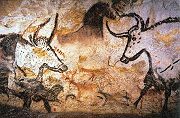
Human evolution (origins of society and culture)
Encyclopedia
While for many specialists, the term 'human evolution' should be restricted to the physical emergence of Homo sapiens as a distinct species, others – notably Chris Stringer and Stephen Oppenheimer – argue that associated cognitive, social and cultural developments are equally legitimate topics of study. 'Human evolution', for these scholars, is the evolutionary emergence of modern human anatomy in association with modern cognition and culture including language.
One theory, strongly supported by archaeologist Richard Klein, is that when Homo sapiens emerged in Africa some 200,000 years ago, humans were 'modern' only anatomically, while behaviourally and cognitively they remained archaic. Klein posits a genetic mutation for language which occurred as recently as 50,000 or 40,000 years ago, corresponding in Eurasia to the 'Upper Palaeolithic' transition and in Africa to the Later Stone Age. According to this view, the Eurasian Neanderthals (along with archaic counterparts elsewhere in the world) became extinct because they lacked the necessary cognitive equipment for language. In support of this view, Klein points to the almost complete lack of evidence for art or personal ornamentation among pre-modern humans, contrasting this with the extraordinarily impressive 'symbolic' cultural artefacts – including sophisticated carved figurines and cave-paintings – produced by modern humans as they migrated out of Africa from around 50,000 years ago. This sudden mutation theory is known as 'the human revolution'; until recently, it was the prevailing view. At the opposite extreme stand archaeologists such as Sally McBrearty and Alison Brooks, who argue that the original 'human revolution' theory reflects a profound Eurocentric bias. Recent archaeological evidence, they argue, proves that humans evolving in Africa some 300,000 or even 400,000 years ago were already becoming cognitively and behaviourally 'modern'. These features include blade and microlithic technology, bone tools, increased geographic range, specialized hunting, the use of aquatic resources, long distance trade, systematic processing and use of pigment, and art and decoration. These items do not occur suddenly together as predicted by the ‘‘human revolution’’ model, but at sites that are widely separated in space and time. This suggests a gradual assembling of the package of modern human behaviours in Africa, and its later export to other regions of the Old World.
At the opposite extreme stand archaeologists such as Sally McBrearty and Alison Brooks, who argue that the original 'human revolution' theory reflects a profound Eurocentric bias. Recent archaeological evidence, they argue, proves that humans evolving in Africa some 300,000 or even 400,000 years ago were already becoming cognitively and behaviourally 'modern'. These features include blade and microlithic technology, bone tools, increased geographic range, specialized hunting, the use of aquatic resources, long distance trade, systematic processing and use of pigment, and art and decoration. These items do not occur suddenly together as predicted by the ‘‘human revolution’’ model, but at sites that are widely separated in space and time. This suggests a gradual assembling of the package of modern human behaviours in Africa, and its later export to other regions of the Old World.
Between these extremes is the view – currently supported by archaeologists Chris Henshilwood, Curtis Marean, Ian Watts and others – that there was indeed some kind of 'human revolution' but that it occurred in Africa and spanned tens of thousands of years. The term 'revolution' in this context would mean not a sudden mutation but a historical development along the lines of 'the industrial revolution' or 'the Neolithic revolution'. In other words, it was a relatively accelerated process, too rapid for ordinary Darwinian 'descent with modification' yet too gradual to be attributed to a single genetic or other sudden event. These archaeologists point in particular to the relatively explosive emergence of ochre crayons and shell necklaces apparently used for cosmetic purposes. These archaeologists see symbolic organisation of human social life as the key transition in modern human evolution. Recently discovered at sites such as Blombos Cave and Pinnacle Point, South Africa, pierced shells, pigments and other striking signs of personal ornamentation have been dated within a time-window of 70,000 – 160,000 years ago in the African Middle Stone Age, suggesting that the emergence of our species coincided, after all, with the transition to modern cognition and behaviour. While viewing the emergence of language as a 'revolutionary' development, this school of thought generally attributes it to cumulative social, cognitive and cultural evolutionary processes as opposed to a single genetic mutation. A further view, taken by archaeologists such as Francesco D'Errico and João Zilhão, is a multi-species perspective arguing that evidence for symbolic culture in the form of utilised pigments and pierced shells are also found in Neanderthal sites, independently of any 'modern' human influence.
A further view, taken by archaeologists such as Francesco D'Errico and João Zilhão, is a multi-species perspective arguing that evidence for symbolic culture in the form of utilised pigments and pierced shells are also found in Neanderthal sites, independently of any 'modern' human influence.
References
One theory, strongly supported by archaeologist Richard Klein, is that when Homo sapiens emerged in Africa some 200,000 years ago, humans were 'modern' only anatomically, while behaviourally and cognitively they remained archaic. Klein posits a genetic mutation for language which occurred as recently as 50,000 or 40,000 years ago, corresponding in Eurasia to the 'Upper Palaeolithic' transition and in Africa to the Later Stone Age. According to this view, the Eurasian Neanderthals (along with archaic counterparts elsewhere in the world) became extinct because they lacked the necessary cognitive equipment for language. In support of this view, Klein points to the almost complete lack of evidence for art or personal ornamentation among pre-modern humans, contrasting this with the extraordinarily impressive 'symbolic' cultural artefacts – including sophisticated carved figurines and cave-paintings – produced by modern humans as they migrated out of Africa from around 50,000 years ago. This sudden mutation theory is known as 'the human revolution'; until recently, it was the prevailing view.

Between these extremes is the view – currently supported by archaeologists Chris Henshilwood, Curtis Marean, Ian Watts and others – that there was indeed some kind of 'human revolution' but that it occurred in Africa and spanned tens of thousands of years. The term 'revolution' in this context would mean not a sudden mutation but a historical development along the lines of 'the industrial revolution' or 'the Neolithic revolution'. In other words, it was a relatively accelerated process, too rapid for ordinary Darwinian 'descent with modification' yet too gradual to be attributed to a single genetic or other sudden event. These archaeologists point in particular to the relatively explosive emergence of ochre crayons and shell necklaces apparently used for cosmetic purposes. These archaeologists see symbolic organisation of human social life as the key transition in modern human evolution. Recently discovered at sites such as Blombos Cave and Pinnacle Point, South Africa, pierced shells, pigments and other striking signs of personal ornamentation have been dated within a time-window of 70,000 – 160,000 years ago in the African Middle Stone Age, suggesting that the emergence of our species coincided, after all, with the transition to modern cognition and behaviour. While viewing the emergence of language as a 'revolutionary' development, this school of thought generally attributes it to cumulative social, cognitive and cultural evolutionary processes as opposed to a single genetic mutation.

References
See also
- Origins of societyOrigins of societyThe origins of society — the evolutionary emergence of distinctively human social organization — is an important topic within evolutionary biology, anthropology, prehistory and palaeolithic archaeology. While little is known for certain, debates since Hobbes and Rousseau have returned again and...
- Behavioral modernityBehavioral modernityBehavioral modernity is a term used in anthropology, archeology and sociology to refer to a set of traits that distinguish present day humans and their recent ancestors from both living primates and other extinct hominid lineages. It is the point at which Homo sapiens began to demonstrate a...
- Prehistoric artPrehistoric artIn the history of art, prehistoric art is all art produced in preliterate, prehistorical cultures beginning somewhere in very late geological history, and generally continuing until that culture either develops writing or other methods of record-keeping, or it makes significant contact with another...
- Symbolic cultureSymbolic cultureSymbolic culture is a concept used by archaeologists, social anthropologists and sociologists to differentiate the cultural realm constructed and inhabited uniquely by Homo sapiens from ordinary "culture", which many other animals possess. Symbolic culture presupposes more than the ability to learn...
- Timeline of evolutionTimeline of evolutionThis timeline of evolution of life outlines the major events in the development of life on planet Earth since it first originated until the present day. In biology, evolution is any change across successive generations in the heritable characteristics of biological populations...
- The Human Revolution (human origins)The Human Revolution (human origins)'The Human Revolution' is a term used by archaeologists, anthropologists and other specialists in human origins; it refers to the spectacular and relatively sudden – apparently revolutionary – emergence of language, consciousness and culture in our species...
- Blombos CaveBlombos CaveBlombos Cave is a cave in a calcarenite limestone cliff on the Southern Cape coast in South Africa. It is an archaeological site made famous by the discovery of 75,000-year-old pieces of ochre engraved with abstract designs and beads made from Nassarius shells, and c. 80,000-year-old bone tools...

